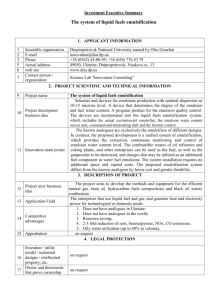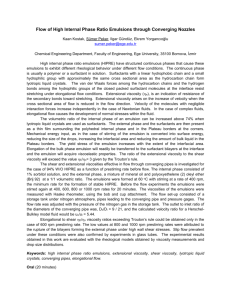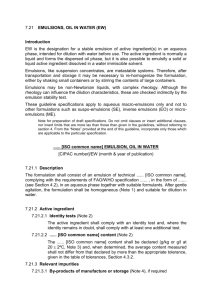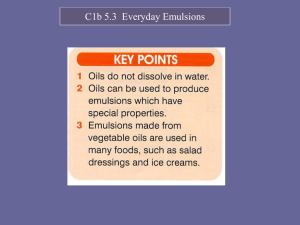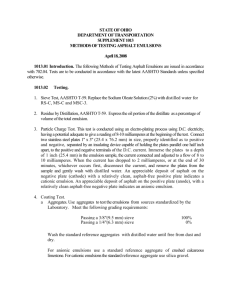Water in Oil Emulsification
advertisement
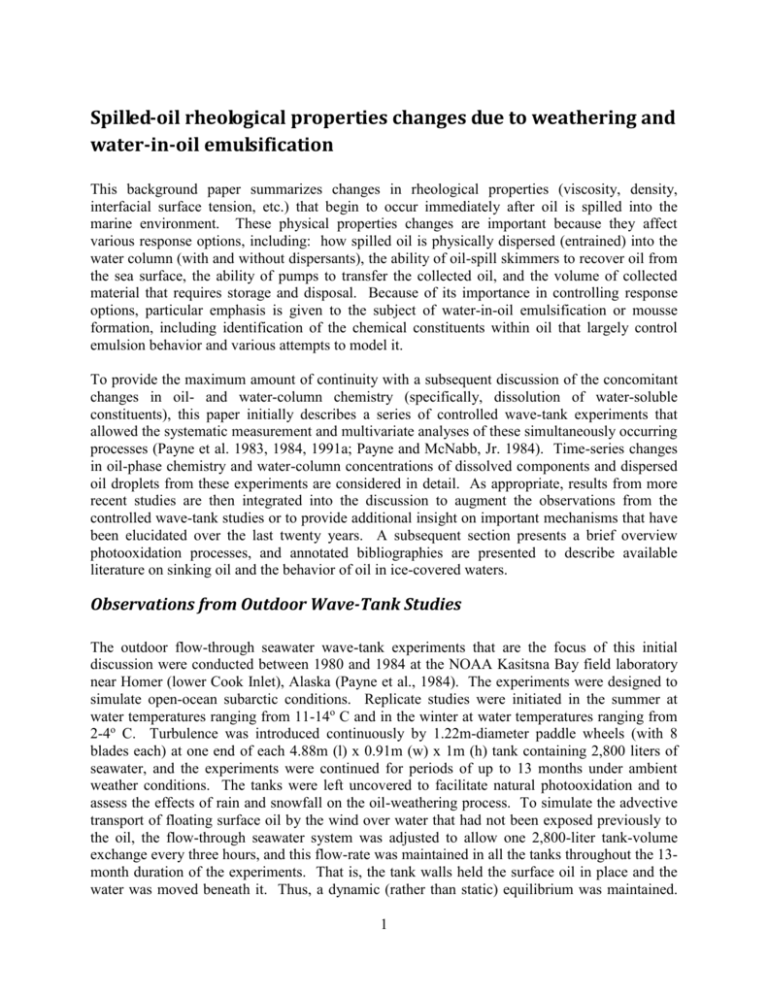
Spilled-oil rheological properties changes due to weathering and water-in-oil emulsification This background paper summarizes changes in rheological properties (viscosity, density, interfacial surface tension, etc.) that begin to occur immediately after oil is spilled into the marine environment. These physical properties changes are important because they affect various response options, including: how spilled oil is physically dispersed (entrained) into the water column (with and without dispersants), the ability of oil-spill skimmers to recover oil from the sea surface, the ability of pumps to transfer the collected oil, and the volume of collected material that requires storage and disposal. Because of its importance in controlling response options, particular emphasis is given to the subject of water-in-oil emulsification or mousse formation, including identification of the chemical constituents within oil that largely control emulsion behavior and various attempts to model it. To provide the maximum amount of continuity with a subsequent discussion of the concomitant changes in oil- and water-column chemistry (specifically, dissolution of water-soluble constituents), this paper initially describes a series of controlled wave-tank experiments that allowed the systematic measurement and multivariate analyses of these simultaneously occurring processes (Payne et al. 1983, 1984, 1991a; Payne and McNabb, Jr. 1984). Time-series changes in oil-phase chemistry and water-column concentrations of dissolved components and dispersed oil droplets from these experiments are considered in detail. As appropriate, results from more recent studies are then integrated into the discussion to augment the observations from the controlled wave-tank studies or to provide additional insight on important mechanisms that have been elucidated over the last twenty years. A subsequent section presents a brief overview photooxidation processes, and annotated bibliographies are presented to describe available literature on sinking oil and the behavior of oil in ice-covered waters. Observations from Outdoor Wave-Tank Studies The outdoor flow-through seawater wave-tank experiments that are the focus of this initial discussion were conducted between 1980 and 1984 at the NOAA Kasitsna Bay field laboratory near Homer (lower Cook Inlet), Alaska (Payne et al., 1984). The experiments were designed to simulate open-ocean subarctic conditions. Replicate studies were initiated in the summer at water temperatures ranging from 11-14o C and in the winter at water temperatures ranging from 2-4o C. Turbulence was introduced continuously by 1.22m-diameter paddle wheels (with 8 blades each) at one end of each 4.88m (l) x 0.91m (w) x 1m (h) tank containing 2,800 liters of seawater, and the experiments were continued for periods of up to 13 months under ambient weather conditions. The tanks were left uncovered to facilitate natural photooxidation and to assess the effects of rain and snowfall on the oil-weathering process. To simulate the advective transport of floating surface oil by the wind over water that had not been exposed previously to the oil, the flow-through seawater system was adjusted to allow one 2,800-liter tank-volume exchange every three hours, and this flow-rate was maintained in all the tanks throughout the 13month duration of the experiments. That is, the tank walls held the surface oil in place and the water was moved beneath it. Thus, a dynamic (rather than static) equilibrium was maintained. 1 This allowed dissolved and dispersed oil to be removed from the water column by advective processes and ambient levels of nutrients, bacteria, and suspended particulate material (SPM) to be continuously introduced into the tanks throughout the experiments. At the initiation of each experiment, 16 liters of fresh Prudhoe Bay crude oil were spilled into the tanks. Time-series samples of oil and water then were collected for physical properties and chemical analyses. When introduced into the tanks, the oil spread readily to a variety of thicknesses throughout the tank. Estimated oil coverage and thickness (NRC 1985) ranged in a gradient from no oil coverage (open water) near the paddles, to a colorless and silver sheen (0.05-0.2 m), to broken rainbow colors (0.2-0.8 m), to nearly continuous (opening and closing) dull brown (1-4 m) and dark brown patches (10-100 m), to black continuous coverage (~1 mm to 1 cm thick) at the opposite end of the tanks. Within eight hours, the oil viscosity had increased to the point that it was much easier to identify the oil-water discontinuity at the leading (open water) edge of the slicks one to two meters from the paddle wheels. Silver and rainbow-colored sheen still emanated from the slicks onto the open water, but the bulk of the oil coverage was thicker and much more continuous. After 24 hours, the oil viscosity had increased to a level at which rising air bubbles (introduced into the water from the paddle wheels) were trapped in the oil for several minutes before breaking. After 72 hours, the increasing oil viscosity permitted seawater (splashed by waves on top of the slicks) to persist in pools on the oil surface for 20-30 seconds. Eventually, the water droplets were worked into and through the oil by wave-induced stretching and compression of the slicks. After nine days, the oil had formed a stable water-in-oil emulsion with a light chocolate brown color. The viscosity allowed the oil to open and close in a mosaic pattern as waves passed beneath it. Over a four-month period (August to November), the oil patches broke up into discrete 10-15 cm tarballs. Throughout this period (fall to early winter), there was no evidence of microbial degradation (see chemical discussion below), and the tarballs did not slough off oil droplets or flakes. Over the period from late fall through the following March, however, the onset of surface microbial degradation of the tarballs was evident, and this increased dramatically during the spring and early summer (March through July). Microbial degradation was manifest by the sloughing off of 1-2 cm flakes of weathered oil, and chemical analyses of these flakes showed significant removal of the n-alkanes compared to the isoprenoid components, pristane and phytane. In contrast, analyses of the tarballs themselves showed variable results. The outside surfaces exhibited microbial degradation of some of the n-alkanes compared to the isoprenoids, whereas, the interior of the tarballs still had a chemical composition identical to that observed at the 12-day stage of weathering. After 13 months, the oil was observed as distinct tarballs. However, there was significant sloughing off of flakes from the outer surfaces, the water contained significant quantities of algal material, and barnacles were growing on the walls throughout the tanks. 2 Rheological Properties Changes Associated with Oil Weathering and Water-in-Oil Emulsification Figure 1 summarizes the changes in bulk physical properties and water content in the oil during the summer flow-through wave-tank experiments. The water content of the oil remained at less than 5 percent for the first 24 hours. However, as the volatile and water soluble lower molecular weight constituents were removed and water-in-oil emulsification ensued, the water content increased to 50-60 percent over the next 6 to 10 days. During this weathering process, the density increased from 0.88 to 0.98 g/mL due to evaporation of lighter hydrocarbons and water incorporation. This density increase was insufficient, however, for the emulsified oil to sink because the seawater had a density of 1.024 g/mL. If water contains adequate SPM, the interaction of dispersed oil droplets with SPM can enhance sinking and sedimentation. This is not usually a significant factor, however, unless SPM concentrations exceed 100 mg/L in the water column (Boehm 1987; Payne et al. 1987a,b; 2003). The viscosity (measured at 38o C) increased from 16 centipoise (cP) to 2,800 cP over the first 12 days of the experiment due both to evaporation and water-in-oil emulsion formation. However, the latter process proved to be the more important. The viscosity data for evaporative weathering alone (in a pan placed next to the wave tanks) show an increase from 16 to only 100 cP over the same period. As noted, viscosity is temperature-dependent. Therefore, the values in Figure 1 were obtained at a laboratory-controlled temperature of 38o C to provide maximum reproducibility. When measured at the ambient temperatures in the wave tanks, viscosity increases were even more significant. During the summer experiments, the ambient temperature (12-14o C) viscosity increased from around 68 to 2,300 cP after only three days. For the fall/winter ice-free experiments at 2-4o C, the in situ viscosity increases were more significant, with initial values increasing from 270 to 5,600 cP after only 24 hours. In -30o cold room experiments (seawater temp -1.8o C), stable, 64% water-in-oil emulsions with fresh Prudhoe Bay crude oil were observed in a broken pancake/slush-ice field under the influence of a rapidly attenuating wave train after as little as 4 hours (Payne et al., 1991b). Essentially no evaporation weathering had occurred before emulsification, and the in situ (-2o C) viscosity was 25,000 cP. When the emulsion was warmed to 38o C to facilitate comparisons to the open-water experiments, the viscosity was 1,100-1,400 cP. It was believed that emulsification process was accelerated by the micro-scale turbulence of the grinding slush-ice platelets and ice pans in the undulating wave train along with the extremely cold temperatures possibly causing asphaltenes, resins, and waxes to precipitate out of the oil. During the open-water experiments, the oil/water interfacial surface tension also changed over time, decreasing from 27 dynes/cm to 10-14 dynes/cm with the incorporation of water and the formation of photooxidation (Payne and Phillips 1985a; NRC 2003) and, possibly, microbial degradation products. The oil/air interfacial surface tension remained essentially unchanged. In the cold-room experiments with sea ice, neither the oil/air nor oil/water interfacial surface tensions changed as the emulsion was formed. To put the concept of centipoise (cP) viscosity values into the proper context, Table 1 presents several examples of measured viscosities for food and common household items encountered in day-to-day activities. 3 Figure 1. Changes in various physical properties of Prudhoe Bay crude oil as a function of weathering time and water-in-oil emulsification. The values given are means from three replicate summer wave tank experiments + one standard deviation (from Payne et al. 1983, 1984). 4 Table 1. Example Viscosities of Foods and Other Liquids* Product Water Ethyl alcohol Olive oil Olive oil Olive oil Glycerin Glycerin Glycerin Pancake syrup Castor oil Castor oil Castor oil Castor oil Honey Chocolate syrup Ketchup Peanut butter Temperature (oC) 20 20 40 20 10 20 0 -20 20 100 40 20 10 20 20 20 20 Viscosity (cP) 1.0 1.2 36 84 138 1,490 12,110 134,000 2,500 17 321 986 2,420 10,000 25,000 50,000 250,000 * Data from CRC Handbook of Chemistry and Physics (48 th Edition) and Transtronics® (2000). As the above data illustrate, the ambient-temperature (13o C) water-in-oil emulsion or mousse generated in the summer wave-tank experiments had the consistency of nominal roomtemperature pancake syrup after as little as three days. During the fall/winter wave-tank studies, the ambient-temperature viscosity of the mousse on the water surface was closer to that of roomtemperature honey after as little as 24 hours, and in the cold-room/ice-chamber experiments the -2o C in situ viscosity was similar to room temperature chocolate syrup. Emulsification occurs in the presence of mixing energy such as that provided by wave action. During emulsification, seawater is incorporated into the oil in the form of microscopic droplets ranging in size from <1 µm to over 100 µm (Daling and Brandvik 1989). This water uptake results in several undesirable changes to the oil. First there is a significant increase in the bulk volume of oil (usually up to a four-or five-fold increase) that generally increases the amount of oily material that can contaminate shorelines and biological resources. Secondly, there is a marked increase in oil viscosity. The much higher viscosity significantly inhibits chemical or natural dispersion of oil droplets, and it affects other response considerations such as vacuum recovery, materials handling/pumping, the use of skimmers, and in situ burning (Twardus 1980; Fingas and Laroche 1991). In addition, the spreading of the emulsion is reduced, further evaporation is retarded (Ross and Buist 1995), and the density of the emulsion increases resulting in the product riding lower in the water and showing different drag with respect to the wind (Fingas 2007). In the ice-chamber experiments, the emulsion was observed actually riding beneath the slush ice at the ice-water interface (Payne et al., 1991b). 5 Identification of Weathering Mechanisms and Oil Components Responsible for Stable Water-in-Oil Emulsification Significant progress has been made in the identification of factors affecting water-in-oil emulsification (Birdie et al. 1980a,b; Zagorski and Mackay 1982; Payne and Phillips 1985b; Mackay 1987; Bobra 1990, 1991; Daling et al., 1990; Fingas and Fieldhouse 1994; Fingas et al. 1995a,b, 1996, 1999; Walker et al 1993a,b, 1995b), and these and other studies have been summarized in an excellent review by Fingas and Fieldhouse (2006). Likewise, the most significant improvements in modeling emulsion formation are presented in Fingas and Fieldhouse (2006) and Fingas (2007). These authors have developed empirical relationships from studies with over 400 oils and petroleum products correlating emulsion stability with rheological properties of the parent oils (density, and viscosity) and percent saturates, aromatics, resins, and asphaltenes (SARA; Jokuty et al. 1995), and (to a much lesser extent) waxes. In earlier studies, Fingas et al. (1998) grouped emulsions into four stability categories based on distinct physical properties: stable, meso-stable, entrained water, and unstable. According to Fingas and Fieldhouse (2006), stable emulsions exhibit a viscosity that is at least three orders-of-magnitude greater than that of the starting oil when measured at a shear rate of one reciprocal second, or at least six orders-of-magnitude greater than the starting oil with a zero-shear-rate measurement. Stable emulsions are brown semi-solid materials with an average water content of 60-80% on the day of formation and about the same a week later. They also remain stable under laboratory conditions for at least 4 weeks, and some stable emulsions have been observed to last for over a year. Mesostable water-in-oil emulsions exhibit a viscosity that is only 45 times greater that of the starting oil on the day of formation and 30 times greater after one week. They are brown, reddish-orange, or black liquids with an average water content of 62% on the day of formation and about 38% one week later. Entrained water-in-oil states can have very high viscosities that overlap mesostable emulsions, but this is usually due to the much higher starting viscosities of the oils (increases of 13 times that of the starting oil on day one and 2 times the starting oil after one week have been measured), but they generally last less than 1 day under laboratory conditions. They are black liquids with an average water content of 42% on the first day and about 15% one week later. They are usually generated from heavier oils with a very narrow density range (0.97-0.99 g/mL) with high initial viscosities (2,000 to 60,000 mPa.s.). Unstable water-in-oil emulsions are characterized by the fact that the oil does not hold significant amounts of water, and when it does, the water remains for only a short time, usually a matter of minutes. Unstable emulsions can have viscosities as much as one-to-two orders-of-magnitude greater than the starting oil, but they do not exhibit significant elasticity whereas stable emulsions do. Oils forming unstable emulsions can have a very wide range of physical properties (e.g., viscosities can be very low or very high), and they often include light fuels such as diesel and very heavy crude oils or fuels, such as Bunker C. 6 In an attempt to generate a database of oil properties that might be useful in predicting water-inoil emulsification and dispersability behavior as a function of the degree to which oil weathering has occurred, Daling et al. (1990) undertook the systematic study of emulsification behavior on three standard test oils that had been artificially weathered in the laboratory. To simulate evaporation weathering, the crude oils were topped (distilled to remove components boiling below the specified temperature) at 150o, 200o, and 250o C. According to Daling et al., this approach approximated 0.5-1 hour, 0.5-1 day, and 2-5 days (depending on weather conditions) of evaporative loss at sea, respectively (Stiver and Mackay 1984). Compared to the evaporative weathering losses observed in the wave-tank experiments by Payne et al. (1984), these distillation losses actually more closely approximate a significantly longer weathering period (at least for open-water subarctic conditions). As discussed further in a following section, compounds below n-C9 (B.P. 150o C) were not completely removed in the wave-tank experiments until 48 hours, and compounds between n-C9 and n-C11 (B.P. 195o C) were not lost until 10-12 days. Loss of components below n-C14 (B.P. 253o C) took up to seven months for the heavily emulsified tarballs generated in Payne et al.’s wave-tank studies; however, the wave-tank oil weathering behavior occurred under colder outdoor conditions, and evaporation losses were most likely retarded by water-in-oil emulsification and thicker oil slicks. Also, the modelpredicted behavior based on Stiver and Mackay (1984) used by Daling et al. does not allow for variable slick thicknesses, and water-in-oil emulsification was not a factor with the topping procedure used in the laboratory by Daling et al. (1990). Daling et al. (1990) also photolyzed the fresh crude oils for 20 hours in some of their experiments. This caused an additional evaporative loss of volatile components that was similar to the 250o C plus topped oil samples. Finally, the topped and the photolyzed oil samples were emulsified (after evaporation) with 50 percent and 75 percent seawater by mechanical stirring and dropwise addition of seawater. The physical chemical properties of the fresh, topped, and photolyzed oil samples were characterized for: specific gravity, viscosity, pour point, flash point, oil-water interfacial surface tension, and asphaltene content (using conventional methods), and aliphatic, aromatic, and resin content (by Iatroscan TLC/FID). This latter technique, Iatroscan thin layer chromatography (TLC) with flame ionization detection (FID), has since been further developed and was recently described more fully by Stephens et al. (1999). TLC/FID uses precision manufactured thin layer media (silica-fused quartz rods) coupled to a conventional FID detection system. A chromatographic profile is obtained (called an Iatroscan chromatogram) that allows the direct measurement of the relative percentages of four major fractions of petroleum: aliphatics, aromatics, resins, and asphaltenes. A limitation is that specific compounds cannot be identified or associated with specific fractions, but this approach can be very useful in quickly and economically characterizing crude oils to make predictions about a particular oil’s potential for forming stable water-in-oil emulsions. It has long been recognized that the indigenous petroleum emulsifying agents are contained in the higher boiling fractions (boiling points > 350-400o C), and particularly in the non-distillable residuum (Lawrence and Killner 1948). These higher boiling fractions contain the highermolecular-weight asphaltenes, resins, and waxes that are the necessary emulsifying agents for 7 stable water-in-oil emulsion formation. Asphaltene and resin films form highly viscoelastic barriers to coalescence of water droplets within the continuous oil phase preventing oil-water separation. Asphaltenes are compounds that are soluble in aromatic solvents but insoluble in alkane solvents. They generally are considered to consist of condensed aromatic nuclei that contain alkyl and alicyclic moieties with heteroatoms (e.g., nitrogen, oxygen, sulfur, metals, and salts) in various structural locations. Asphaltenes will have carbon numbers of 30 or greater and molecular weights of 400 to 10,000. A hypothetical structure of a representative California crude oil asphaltene was proposed by Bobra (1990). Resins are complex higher-molecular-weight compounds containing oxygen, nitrogen, and sulfur atoms. They are polar materials and have strong adsorption tendencies. They normally will remain in solution in crude oils following precipitation of the asphaltenes (e.g., by dilution with alkane solvents), and they can include photooxidation products such as carboxylic acids, ketones, alcohols, and phenols. Molecular weights for resins are generally in the range of 800 to 1,500. Waxes are hydrocarbon materials in asphaltene/resin-free oil that are insoluble in methylene chloride and methyl ethyl ketone at -10o C (Bridie et al. 1980a,b). Petroleum waxes are also defined as higher molecular weight paraffinic substances (e.g., aliphatics) that crystallize out of solution when an oil is cooled below its pour point. Petroleum waxes are generally divided into two groups: paraffin wax and microcrystalline wax. Paraffin waxes are normal alkanes (n-alkanes) with carbon numbers of 20 to 40 and melting points of 30 to 70o C. Microcrystalline waxes mainly consist of iso-alkanes with carbon numbers of 35 to 75 with melting points of 50 to 100o C. While it was initially believed that waxes were important for emulsion stability, Fingas (2007) and Fingas and Fieldhouse (2006) believe that they are probably only important in special circumstances where entrained water states (and possibly some mesostable emulsions) may be stabilized by higher viscosities due to waxes precipitating out of the oil phase. It is now known that to be effective, these emulsifying agents must be in the form of solid, finely divided, submicron particles (Bobra 1990, 1991). Secondly, it has been shown that the lowermolecular-weight alkane and aromatic components in fresh crude oils serve as solvents to control the in situ solubility and precipitation behavior of these higher-molecular-weight constituents. Thus, in developing their empirical relationships of oil viscosity and density along with the SARA content, Fingas and Fieldhouse (2006) also “weather” the test oils to different percent evaporated losses in developing their emulsification model. The chemical composition of the oil also determines the amount and size of the precipitated asphaltenes, resins, and waxes, as well as the “wetting” properties of those particles. In addition to the influence of asphaltenes (and possibly waxes), oxidation products from oil photolysis have also been suspected to play a significant role in water in emulsification behavior (Payne and Phillips 1985a,b). Daling and Brandvik (1989) and Daling et al. (1990) correlated the increase in resin components in photolyzed oils with increased water contents and smaller sized water droplets in the resultant water emulsions. Specifically they found that photolysis results in: the formation of polar compounds (resins), significant reductions in oil-water interfacial surface tension slightly increased rates of water-in-oil emulsion formation (not for waxy crudes) 8 slightly higher maximum water content in the water-in-oil emulsion significantly higher stability in viscosity of the water-in-oil emulsion a higher concentration of chemicals needed to break or inhibit water-in-oil emulsion formation, and oil-specific changes in chemical dispersability o Naphthenic crudes were more highly dispersible after photolysis o waxy crudes showed drastic reduction in dispersability: (photolyzed components were thought to facilitate the accumulation of waxes at the oil-water interface, which was believed to "block" the access and penetration of the dispersant’s surfactant into the oil phase). Without such stabilizing agents the water droplets in a water-in-oil emulsion will tend to coalesce and separate from the oil phase. Because of the lack of asphaltenes and high molecular waxes and resins, most refined products (such as gasoline, kerosene, heating oil, and diesel fuels) do not easily form a stable water-in-oil emulsion. Fieldhouse (2007) investigated the importance of salinity in water-in-oil formation and stability for five crude oils. Oils that form emulsions in salt water will also form in fresh water, in generally the same stability class, but they had slightly less stability than their salt-water counterparts. There was little distinction observed for stable and meso-stable emulsions between those formed from 20 ppt and 33 ppt salt water, but fresh water meso-stable emulsions gave variable results compared to salt-water emulsions with the same oils. Entrained water states exhibited no differences in emulsion product as a function of the water’s salinity, but this was probably due to the entrapment of water in the higher viscosity oils rather than ionic stabilization of finite water droplets within the oil phase. Although they were unable to measure the turbulent energy necessary for stable emulsion formation in the laboratory, Fingas et al. (1999) found that the energy threshold necessary for the onset of emulsification for the four above-described classification states was very low (300 to 1,500 ergs). In a subsequent paper, Fingas et al. (2000b) noted that there was a distinct progression in the formation of emulsions. At the onset of agitation, a coarse mixture appearing like a sponge or foam was formed. If a stable emulsion could be formed with a particular oil, then it occurred quickly after that stage and was never observed to revert (at lease with the oils in their study). Their research also showed that for Bunker C, which forms the least stable entrained-water “state,” there was no increase in stability with increasing energy input after the initial formation point. With Prudhoe Bay crude oil, which formed a meso-stable emulsion, they observed a similar tendency, in that after energy onset, which occurred at a higher level of about 25,000 ergs, there was no apparent increase in stability with additional energy input. They did not, however, allow the oil to evaporate during that experiment, which would preclude the necessary precipitation of asphaltenes and waxes. Payne et al. (1984) and others (e.g., Bobra 1990) have observed stable emulsions with Prudhoe Bay crude oil after evaporative weathering, and certainly, stable emulsions were noted after the release of 11,000,000 gallons of Alaska North Slope crude oil with the Exxon Valdez oil spill. Both Alberto Light and Sockeye crude oils, which formed stable emulsions in Fingas’ studies, showed increasing stability with additional energy input, although the rate of increase was gradual with increasing energy. Fingas et al. (2000b) could not measure turbulent energy directly with their experimental apparatus, so 9 they quantified the total energy input to the system as Work (Joules). Their studies showed that although only a minimal energy threshold is necessary for the initiation of most emulsion formation, only Work correlates with the final value of emulsion stability. This finding was believed to have implications for the formation of emulsions at sea, where a given energy level corresponding to turbulent energy at sea would sometimes require a period of time before a given water-in-oil state would be produced. In this context, their data showed that the Work (energy expended over time) correlated most closely with the stability of the emulsion (or waterin-oil “state”). Modeling Water-in-Oil Emulsion Formation Without question, oil spill emulsification is the most important process that affects oil droplet dispersion and dispersant effectiveness. For years, it has also been a very difficult processes to model or predict on a spill-specific basis. That lead SL Ross (1997) to comment that except for a few oils that have been extensively tested, it is virtually impossible to predict when a particular oil will start to emulsify or how long it will take for the spilled oil to form a "stable" highly viscous emulsion. Likewise, it was believed to be impossible to predict the final water content that a water-in-oil emulsion might contain. Initially, many oil spill models took advantage of data from a laboratory test, called the MackayZagorski Test (Zagorski and Mackay 1982) that was developed to measure: 1) an oils tendency to form an emulsion and 2) the stability of the emulsion once formed. The test does not, however, predict the rate of emulsification under field conditions. Likewise, the conventional emulsification equation (Mackay and Matsugu 1973) that has been generally used in oilweathering modeling includes some inconsistencies. For example, it does not include the influence of initial oil thickness and the progress of evaporation on emulsification. Emulsified oil containing a given amount of water must increase its water content ratio as evaporation progresses. Therefore, Tasaki and Ogawa (1999) developed a new equation and governing parameters for emulsification of crude oil. Through the differentiation of a formula defining the water content ratio, a water-in-oil emulsification equation for crude oil was derived to include the effects of evaporation loss and entrained water with time. The equation reveals that the emulsification is governed by two fixed parameters (related to the evaporation process) and four free constant parameters. Noting the requirement for the loss of lower molecular weight alkane and aromatic solvents to precipitate asphaltenes for the formation of stable mousse with Alaska North Slope (ANS) crude oil, SL Ross (1997) and NOAA (in their ADIOS2 oil weathering model) do not initiate the formation of a water-in-oil emulsion in their computer models until after a specified percent evaporation for the crude oil has occurred. The SL Ross model uses laboratory-measured properties of viscosity, density, and interfacial surface tension on oil that has been evaporated for three hours or two days of exposure on water with different wind speeds. The 25 % volatiles loss condition for the onset of ANS crude oil emulsification in the SL Ross Model may be a reasonable guideline for summertime conditions, but Payne et al. (1984) observed that emulsions occurred much sooner under winter conditions where initial oil viscosities were higher and in the presence of sea ice (Payne et al., 1991b). SL Ross used a cut off point for the time window for effective dispersant application (and the beginning of water-in-oil emulsification process) as that 10 time when 25 percent of the oil would have been evaporated. That may over estimate the time window under winter conditions, where increases in oil viscosity and emulsification are accelerated by the cold water and air temperatures. Given the extensive correlations completed by Fingas and Fieldhouse (2006), it may now be possible to incorporate their approach into the next generation oil-weathering models (at least for the 400 plus oils and petroleum products that they have characterized and tested). In addition, Daling and Strom (1999) have developed an extensive database on weathering data for about 40 crudes and 10 refined products and detailed crude compositional assays (crude oil data only) for another 200 crude oils. A systematic comparison and compilation of the data sets from the two research groups should be undertaken so that these empirical data can be used for predicting oil weathering behavior at sea. This would at least allow an oil-properties-driven approach (incorporating density, viscosity and SARA composition) that also accounts for evaporation losses of the lighter solvent components, and it can yield empirically derived estimates for the water content, stability, and viscosity of the resulting emulsions. A modeling approach incorporating these empirical data could at least provide more reasonable parameterized endpoints for predicted water-in-oil emulsion properties when generated from other oil spillweathering and trajectory models. It might even be possible to link the modeled onset of emulsification to evaporation algorithms currently used in other models. Likewise, it is also possible that the rates of emulsification for those well characterized oils could be tied to winddriven sea-state predictions that are otherwise used for estimating oil-droplet dispersion into the water column. Fingas (2007) modeled the kinetics of emulsion formation based on empirical constants derived from regression analyses of a large number of oils with measured emulsionforming tendencies and the reciprocal of the wave height to the 1.5th power. 11 Cited References Bobra, M. 1990. A study of the formation of water-in-oil formations. In Proceedings of the Thirteenth Arctic and Marine Oil Spill Program Technical Seminar, June 6-8. 87-117. Bobra, M. 1991. Water-in-Oil Emulsification: A Physicochemical Study. In Proceedings of the 1991 Oil Spill Conference. 483-492. Boehm, P.D. 1987. Transport and Transformation Processes Regarding Hydrocarbon and Metal Pollutants in Offshore Sedimentary Environments. Pp. 233-287. In Long-Term Environmental Effects of Offshore Oil and Gas Development, edited by D. F. Boesch and N. N. Rabalais. London & New York: Elsevier Applied Science. Bridie, A.L, Th. H. Wanders, W. Zegveld, and H.B. Van der Heijde. 1980a. The Formation, Prevention and Breaking of Sea-Water-in Crude-Oil Emulsions: "Chocolate Mousse". Paper presented at International Research Symposium, Chemical Dispersion of Oil Spills (Nov. 17-19, 1980a), at Toronto, Canada. Bridie, A.L., Th.H. Wanders, W. Zegveld, and H.B. Van der Heijde. 1980b. Formation, Prevention and Breaking of Sea Water in Crude Oil Emulsions "Chocolate Mousses. Mar. Poll. Bull. 2:343-348. CRC. 1968. CRC Handbook of chemistry and physics. 48th Edition. Daling, P.S., and P.J. Brandvik. 1989. The effects of photolysis on oil slicks. IKU, SINTEF Group. Trondheim, Norway. Daling, P.S. and T. Strom. 1999. Weathering of oils at sea: Model/field data comparisons. Spill Science and Technology Bulletin 5(1): 63-74. Daling, P.S., P.J. Brandvik, D. Mackay, and O. Johansen. 1990. Characterization of crude oils for environmental purposes. In Proceedings of the Thirteenth Arctic and Marine Oil Spill Program Technical Seminar. 119-138. Fieldhouse, B. 2007. Water-in-crude oil emulsions formation and stability for crude oils in fresh, brackish and salt water. In Proceedings of the Thirtieth Arctic and Marine Oilspill Program (AMOP) Technical Seminar. June 5-7, 2007. 897-910. Fingas, M. 2007. Estimation of oil spill behaviour parameters from readily-available oil properties. In Proceedings of the Thirtieth Arctic Marine Oil Spill Program, Technical Seminar. 1-34. Fingas, M., and N. Laroche. 1991, 4-6 November. An Introduction to In Situ Burning of Oil Spills. Unpublished report. Paper read at In Situ Burn Workshop, 1991, at Anchorage, Alaska. 12 Fingas, M., and B. Fieldhouse. 1994. Studies of water-in-oil emulsions and techniques to measure emulsion treating agents. In Proceedings of the Seventeenth Arctic and Marine Oilspill Program Technical Seminar, June 8-10, 1994. 233-244. Fingas, M., and B. Fieldhouse. 2006. A review of knowledge on water-in-oil emulsions. In Proceedings of the Twenty-ninth Arctic and Marine Oilspill Program Technical Seminar, June 6-8, 2006. 156. Fingas, M., B. Fieldhouse, and J.V. Mullin. 1995a. Water-in-oil emulsions: How they are formed and how they are broken. In Proceedings of the 1995 Oil Spill Conference. 829-830. Fingas, M., B. Fieldhouse, L. Gamble, and J.V. Mullin. 1995b. Studies of water-in-oil emulsions: Stability, classes, and measurement. In Proceedings of the Seventeenth Arctic and Marine Oilspill Program Technical Seminar. 21-42. Fingas, M., B. Fieldhouse, and J.V. Mullin. 1996. Studies of water-in-oil emulsions: The role of asphaltenes and resins. In Proceedings of the Nineteenth Arctic and Marine Oilspill Program Technical Seminar, June 12-14, 1996. 73-88. Fingas, M., B. Fieldhouse, and J.V. Mullin. 1998. Studies of water-in-oil emulsions: Stability and oil properties. In Proceedings of the Twenty-First Arctic and Marine Oil Spill Program Technical Seminar, June 10-12, 1998. 1-25. Fingas, M., B. Fieldhouse, and J. Mullin. 1999. Studies of water-in-oil emulsions: Energy threshold on emulsion formation. In Proceedings of the Twenty-Second Arctic and Marine Oil Spill Program Technical Seminar, June 2-4, 1999. 57-68. Fingas, M., B. Fieldhouse, J. Lane, and J. Mullin. 2000a. Studies of water-in-oil emulsions: Long-term stability, oil properties, and emulsions formed at sea. In Proceedings of the Twenty-Third Arctic and Marine Oil Spill Program Technical Seminar, June 14-16, 2000. Fingas, M., B. Fieldhouse, J. Lane, and J. Mullin. 2000b. Studies of water-in-oil emulsions: Energy and work threshold for emulsion formation. In Proceedings of the Twenty-Third Arctic and Marine Oil Spill Program Technical Seminar, June 14-16, 2000. Jokuty, P., M. Fingas, S. Whiticar, and B. Fieldhouse. 1995. A study of viscosity and interfacial tension of oils and emulsions, Environment Canada Manuscript Report Number EE-153, Ottawa, Ontario, 43 p. Lawrence, A.S.C, and W. Killner. 1948. Emulsions of seawater in Admiralty fuel oil with special reference to their demulsification. Journal of the Institute of Petroleum 34 (299):821-857. 13 Mackay, D. 1987. Formation and stability of water-in-oil emulsions. DIWO Report No. 1. IKU. Trondheim, Norway. Mackay, D., and R.M. Matsugu. 1973. Evaporation rates of liquid hydrocarbon spills on land and water. Canadian Journal of Chemical Engineering 51:434-439. National Research Council (NRC). 1985. Oil in the Sea: Inputs, Fates, and Effects. Washington, D.C.: National Academy Press. National Research Council (NRC). 2003. Oil in the Sea III: Inputs, Fates, and Effects. Washington, D.C. National Academy Press. Payne, J.R., B.E. Kirstein, G.D. McNabb Jr., J.L. Lambach, C. de Oliveira, R.E. Jordan, and W. Hom. 1983. Multivariate analysis of petroleum hydrocarbon weathering in the subarctic marine environment. In Proceedings of the 1983 Oil Spill Conference. 423-434. Payne, J.R., and G.D. McNabb, Jr. 1984. Weathering of petroleum in the marine environment. Marine Technology Society Journal 18 (3):24-42. Payne, J.R., B.E. Kirstein, Jr. G.D. McNabb, J.L. Lambach, R. Redding, R.E. Jordan, W. Hom, C. de Oliveira, G.S. Smith, D.M. Baxter, and R. Geagel. 1984. Multivariate analysis of petroleum weathering in the marine environment - subarctic. Volume I, Technical Results; Volume II, Appendices. In: Final Reports of Principal Investigators, Vol. 21 and 22. Juneau, Alaska: U.S. Department of Commerce, National Oceanic and Atmospheric Administration, Ocean Assessment Division. Payne, J.R., and C.R. Phillips. 1985a. Photochemistry of petroleum in water. Environmental Science and Technology 19 (7):569-579. Payne, J.R. and C.R. Phillips. 1985b. Petroleum Spills in the Marine Environment: The Chemistry and Formation of Water-in-Oil Emulsions and Tar Balls. Chelsea, Michigan: Lewis Publishers, Inc. Payne, J.R., B.E. Kirstein, Jr. J.R. Clayton, C. Clary, R. Redding, Jr., G.D. McNabb, and G.H. Farmer. 1987a. Integration of suspended particulate matter and oil transportation study. Final Report submitted to Minerals Management Service, Environmental Studies Branch, Anchorage, Alaska 99508. Payne, J.R., C.R. Phillips, and W. Hom. 1987b. Transport and Transformations: Water Column Processes. Pp. 175-232. In Chapter 5: Long Term Environmental Effects of Offshore Oil and Gas Development., edited by D. F. Boesch and N. N. Rabelais. Elsevier Applied Science Publishers Ltd. 14 Payne, J.R., Jr. J.R. Clayton, Jr. G.D. McNabb, and B.E. Kirstein. 1991a. Exxon Valdez oil weathering fate and behavior: Model predictions and field observations. In Proceedings of the 1991 Oil Spill Conference. 641-654. Payne, J.R., G.D. McNabb, Jr., and J.R. Clayton, Jr. 1991b. Oil-weathering behavior in arctic environments. Polar Research 10(2): 631-662. Payne, J.R., J.R. Clayton, Jr., and B.E. Kirstein. 2003. Oil/suspended particulate material interactions and sedimentation. Spill Science & Technology 8(2): 201-221. Ross, S., and I. Buist. 1995. Preliminary laboratory study to determine the effect of emulsification on oil spill evaporation. In Proceedings of the Eighteenth Arctic and Marine Oilspill Program Technical Seminar, June 14-16, 1995. pp 91-312. S.L. Ross Environmental Research Ltd. 1997. A review of dispersant use on spills of North Slope crude oil in Prince William Sound and the Gulf of Alaska. Ottawa, Ontario: Prince William Sound Regional Citizens' Advisory Council, Anchorage, Alaska. Stephens, F.L., J.S. Bonner, R.L. Autenrieth, and T.J. McDonald. 1999. TLC/FID analysis of compositional hydrocarbon changes associated with bioremediation. In Proceedings of the 1999 Oil Spill Conference, March 8-11, 1999. pp 219-224. Stiver, W., and D. Mackay. 1984. Evaporation rate of oil spills of hydrocarbons and petroleum mixtures. Envir. Sci. and Technol. 18:834-840. Tasaki, R., and A Ogawa. 1999. Emulsification of crude oil: A new equation and governing parameters. In Proceedings of the 1999 Oil Spill Conference, March 8-11, 1999. 1011-1014. Transtronics. 2000. Viscosity. Available from viscosity@xtronics.com. Twardus, E.M. 1980. A Study to Evaluate the Combustibility and Other Physical and Chemical Properties of Aged Oils and Emulsions. Ottawa, Ontario: R & D Division, Environmental Emergency Branch, Environmental Impact Control Directorate, Environmental Protection Service, Environment Canada. Walker, A.H., D.L. Ducey, J.R. Gould, and A.B. Nordvik. 1993a. Formation and Breaking of Water-inOil Emulsions: Workshop proceedings. 303 pp. Walker, M., M. McDonaugh, D. Albone, S. Grigson, A. Wilkinson, and G. Baron. 1993b. Comparison of observed and predicted changes to oil after spills. In Proceedings of the 1993 Oil Spill Conference. 389-393. 15 Walker, A.H., T. Lunel, P.J. Brandvik, and A. Lewis. 1995. Emulsification processes at sea - Forties crude oil. In Proceedings of the Eighteenth Arctic and Marine Oil Spill Program Technical Seminar, June 14-16, 1995. 471-491. Zagorski, W., and D. Mackay. 1982. Studies of water-in-oil emulsions. EPS Report EE-34. Environment Canada. Ottawa. 16
